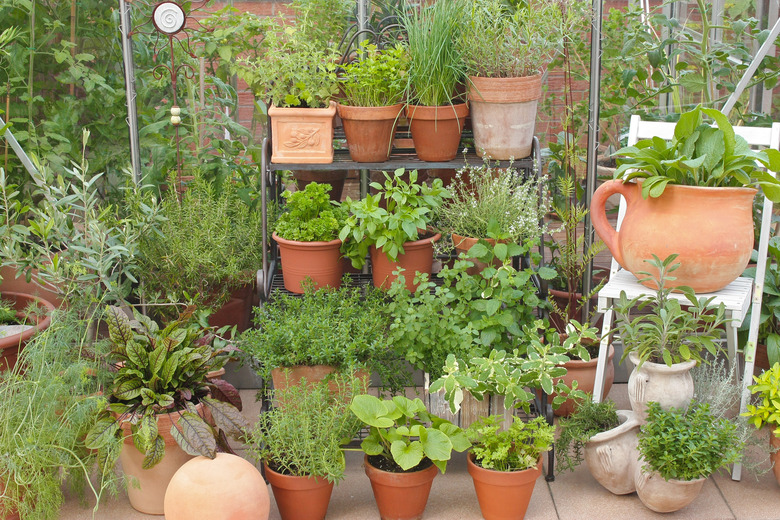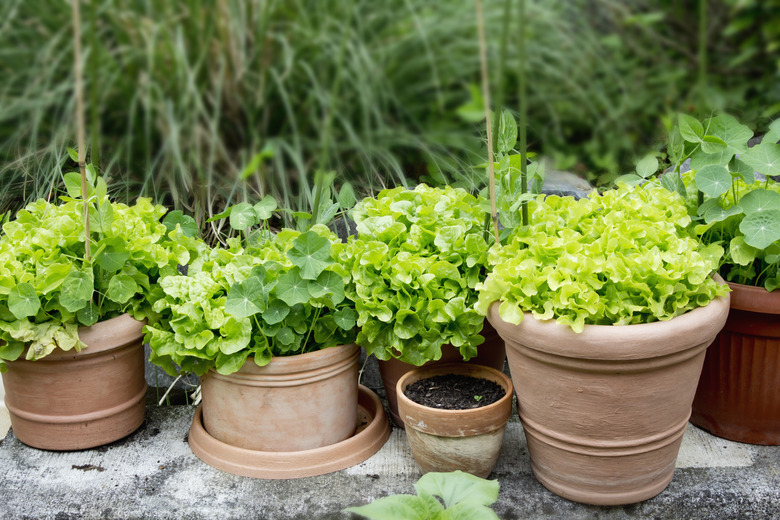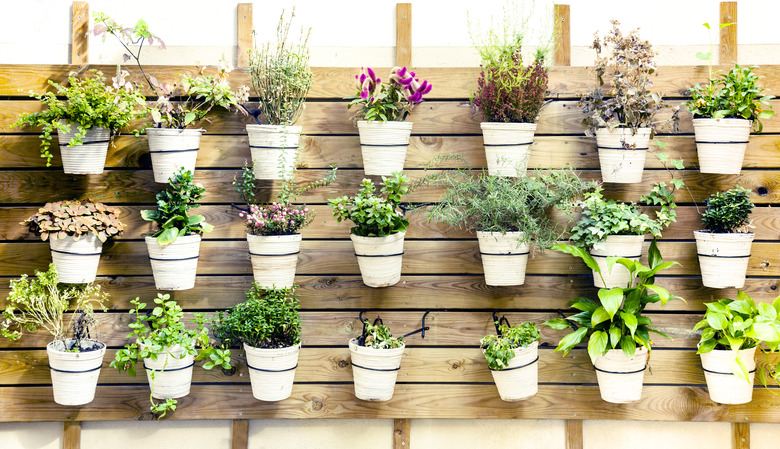Herb Container Gardening — A Beginner's Guide
We may receive a commission on purchases made from links.
Herbs are ideal plants for container gardening, especially ones that may not otherwise thrive in your growing zone. Depending on the material from which they are made, containers keep soil warm, which extends the growing season outdoors, and they make the plants movable, so you can bring them indoors when necessary. When you grow an herb garden in containers, you have more control of soil quality, and it's easier to monitor moisture levels, so you're actually more likely to have a successful garden than you would if you planted straight in the ground.
Most herbs adapt well to container growing, especially annuals, like basil, dill, summer savory, parsley, chervil and cilantro, which are all culinary herbs you can use in the kitchen. Perennial herbs like tarragon, chives, marjoram and oregano also have multiple uses in the kitchen, and as long as you're growing herbs, you'll probably want some herbal tea varieties, such as chamomile (Chamaemelum nobile, zones 4-9), mint, and chicory (Cichorium intybus, zones 3-8). These perennials have taproots that penetrate the soil a little deeper than annual herbs, so they need deeper pots, and they will grow happily in any container that provides enough room for them to spread out.
The Best Herbs for Container Gardening
The Best Herbs for Container Gardening
Most herbs thrive in sparse conditions with well-draining soil and very moderate watering. They all appreciate the full summer sun, although cilantro is an outlier that will bolt (prematurely flower) if it gets too much sun, and mint tolerates partial-shade locations. The best herbs to grow are basically the ones you use most often in the kitchen. The herbs that make most lists include (U. S. Department of Agriculture hardiness zones included for herbs typically grown as perennials):
- Sweet basil (Ocimum basilicum)
- Greek oregano (Oreganum vulgare subsp. hirtum, zones 4-8)
- Chives (Allium spp., zones 3-9 depending on species)
- Rosemary (Salvia rosmarinus, zones 7-10)
- Thyme (Thymus vulgaris, zones 5-9)
- Tarragon (Artemesia spp., zones 3-8 depending on species and cultivar)
- Sage (Salvia officinalis, zones 4-8)
- Cilantro (Coriandrum sativum)
- Lemon balm (Melissa officinalis, zones 3-7)
- Parsley (Petroselinum crispum)
- Chervil (Anthriscus cerefolium, zones 7-9)
- Summer savory (Satureja hortensis)
- Dill (Anethum graveolens)
- Marjoram (Origanum majorana, zones 9-10)
- Mint (Mentha spp., zones 5-9 depending on species)
Many of these have similar moisture requirements and can grow in the same pot, while others need more water and can also grow together but in a different pot. Mint is the exception. It's extremely invasive and will overtake any other plant with which it shares real estate, so it should always be in its own pot. If you let it loose in the garden, you'll be dealing with it for years, so it's one herb that's actually better to grow in a container so you can keep it under control.
How to Choose an Herb Container
How to Choose an Herb Container
Some herbs prefer more moisture than others, but all need well-draining soil to prevent their roots from rotting, and all herb garden containers need drainage holes. Containers can be made from any one of a number of materials, with clay, wood and some type of plastic being the most common. Terra-cotta pots, which are basically unglazed clay, are popular because they are porous, allowing the roots to breathe and providing insulation from the hot sun.
It's also common to see herbs growing in converted metal vessels, such as old watering cans or tea kettles and concrete pots shaped like Buddha heads, which make interesting containers as long as they have the requisite drainage holes. Fabric pots known as Smart Pots are also a great choice; they drain so efficiently that it's almost impossible to overwater.
Individual herb plants tend to have small root systems, so you can grow them in containers the size of paper coffee cups, but because there isn't much soil in a small container, it's easy to make a mistake when watering, giving too much or too little. It's usually better if you use larger containers with a minimum diameter of 6 to 10 inches and a minimum depth of 8 to 10 inches for individual annuals and up to 18 inches for perennials and for growing groups of herbs.
Getting Started With Container Gardening
Getting Started With Container Gardening
You can start a good many herbs from seed, but whether you use seeds or seedlings from your local garden center, they need to be planted in well-draining soil. Seeds need an especially loose seed-starting mix to allow them to germinate, but after they sprout, the seedlings will do better in potting mix with a higher nutrient content. Remember to tease out the roots when you plant seedlings to prevent them from clumping. It's generally a bad idea to try to grow herbs in garden soil that you've transferred to pots because it tends to compact and retain moisture.
If you're planning to start herbs from seeds and move them outdoors, the best time to sow the seeds varies by the herb plant, but it's usually six to eight weeks before the last frost. Check the seed containers to make sure and you should also check for other details, such as how deep to sow the seeds and how far away to space them. Some herbs, such as cilantro, don't take well to transplanting, so if you're going to grow these from seed, make sure the containers have enough room for the mature plants.
Combining Herbs in a Single Container
Combining Herbs in a Single Container
Some herbs have more or less the same water requirements and like to grow together. For example, herbs that originated in the Mediterranean all love full sun and fairly dry soil, and together, they can make a culinary herb garden with an Italian or Greek theme. Some of these herbs include oregano, sage, thyme, lavender (Lavandula spp., zones 5-10 depending on species and cultivar), marjoram and rosemary. Broadleaf sage is a good candidate for the center of the container, flanked by the woodier, sparser branches of the other drought-tolerant herbs, some of which can spill over the sides of the container to save space. On the wetter side, moisture-loving varieties that you can grow in a single herb container include basil, cilantro, tarragon and parsley.
Another thing to keep in mind when growing different herbs in the same pot is to choose varieties that are more or less the same size. Dill plants can reach 2 to 4 feet and can crowd out many smaller herbs, so dill should either be grown as a companion to vegetables, such as Brussels sprouts (Brassica oleracea, Gemmifera Group) or cabbage (Brassica oleracea, Capitata Group), or grown in a container by itself.
Tip
Dill and fennel (Foeniculum vulgare, zones 4-9) look alike because they are related, but they should never be grown together because they can cross-pollinate and produce a bitter-tasting hybrid.
Maintaining and Harvesting Herbs
Maintaining and Harvesting Herbs
Once the herbs in your container garden get off to a good start, they don't usually need much care other than watering and the occasional shot of an organic fertilizer formulated for container growing. Some of the more drought-tolerant herbs, like oregano, won't mind if you forget to water them, but leafy herbs, like basil and parsley, need the extra moisture to produce lush greenery, so be sure to check the soil and water whenever the top inch or two dry out.
One of the great things about growing herbs is that you can harvest them throughout the growing season, and in fact, that's recommended because it encourages the plant's production. Some cooks like to keep fresh herbs growing on a windowsill in the kitchen or in a window box just outside so they have a ready supply of the freshest herbs possible.
When harvesting, always pick new growth from the tips of the branches rather than picking the entire branches from the base. Leaves are at their best when new flowers appear but haven't yet opened. Be sure to snip off the flowers unless you're growing the herbs primarily for seed because once the flowers open, the leaves will lose their taste since all the plant's energy goes into flower and seed production.
References
- University of Illinois Extension: Growing Herbs in Containers
- Savvy Gardening: The 7 Best Herbs for Container Gardening
- Gardening Channel: Container Herb Gardening 101: Best 9 Herbs to Grow in Pots
- Gardener's Supply Company: How to Grow Herbs
- Today's Homeowner: Annual and Perennial Herbs for Your Garden


